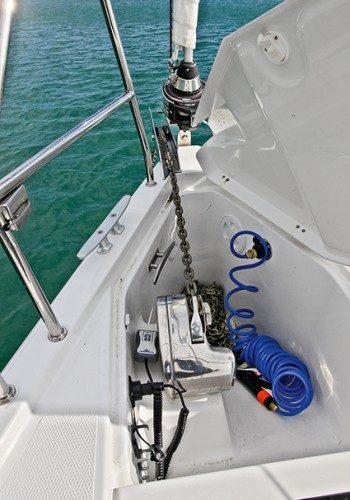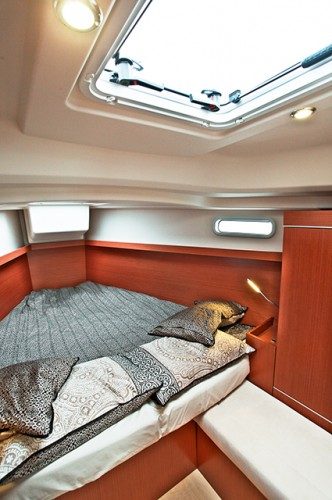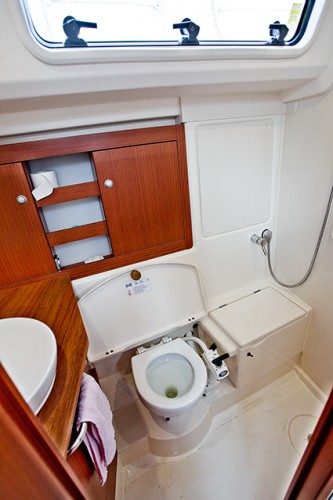‘Behemoth’ is a word which springs to mind or, perhaps more nautically, ‘leviathan’.
- Fold-out swim platform
- Easy, short-handed sailing
- Performance
- Where’s the gennaker?
In less than a year the Hanse 385 has become the German company’s best selling yacht. The 59th boat off the production line has just arrived in New Zealand so Lawrence Schäffler took her for a sail to find out what’s so appealing.
The 385 is the smallest in the revamped range of 5 Series Hanses and follows hot on the heels of her three bigger sisters, the immensely successful 445, 495 and 545. Like them, she’s been penned by the formidable Judel-Vrolijk team and the same genes are present: plumb bow, clear decks, flush-mounted hatches, a powerful rig, twin helms and a spacious, airy interior. Like them, she’s also a dream to sail. Hanse’s yachts have always enjoyed a reputation for hassle-free handling and easy, short-handed sailing but the 385 lifts the bar by quite a margin. Liquidity is the first 385 in New Zealand and belongs to Auckland’s Wally Fitness who bought the boat “off the brochure”, sight unseen, but his preliminary research included tours around (and sails on) a number of other Hanses, and he says he was sold on the marque’s quality and easy-handling traits. “The vast majority of my sailing involves just my partner and I, so features such as the self-tacking headsail and halyards/sheets leading aft to twin helms scored high on my checklist. In fact, my partner often adopts a ‘chill-out’ approach to cruising so I end up sailing the boat alone. She’s a remarkably simple lady – the boat I mean.”

Easy Handling
The best way to appreciate the 385’s single-handed control is from the command centre. There are twin helms so you have a choice of seating, either windward or leeward. Both offer clean sight lines to the jib’s tell tales, but leeward provides a comfy backrest. Sailing bliss.
All halyards and sheets (four per side) lead back through jammers to primary winches at the helms. They’re hidden in recessed, covered channels in the coach roof so there’s a clean, uncluttered sense of space on the boat’s decks.
I far prefer this configuration to the more traditional set-up where halyard, outhauls and reefing lines lead to secondary winches mounted on the coach roof, either side of the companionway. It always makes sail trimming/adjustments in short-handed mode very difficult, with the helmsman having to scramble forward, usually over those dozing in the cockpit. With the 385, winches and jammers are within easy reach so it truly is a single-handed affair, and itchy-fingered, pedantic sail trimmers will be in heaven. It’s all made much simpler with the self-tacking jib using a single sheet, and the continuous main sheet leading to both sides.
Fitness has made the set-up even easier by upgrading the starboard primary winch to an electric model. Die-hard purists can sit at the port winch if they feel the need to crank, but may find the rest of the crew smiling at their eccentricity. All sheets tail neatly into purpose-designed lockers under teak-faced coaming seats, again adding to the sense of uncluttered freedom, but you must coil them neatly as you stow them. Stuffing everything into the bins creates, well, a stuff-up, and untangling spaghetti is not something you want to deal with when trying to reduce sail in a hurry.
However, the pièce de résistance in the easy-handling department isn’t a Hanse creation. It’s the touch-screen Simrad NSS8 chartplotter/autopilot mounted on the end of the cockpit table. It’s on a swivel base so it can be angled to the helmsman, and Fitness has fallen in love with it.
“The auto-pilot has a self-sailing feature – it follows the shifts when you’re clawing your way upwind – and the self-tacking option carries out a textbook tack with the touch of a finger. Brilliant! Though, of course, this is only possible because of the self-tacking jib.”
The cockpit is dominated by the table but there’s still reasonable room to move. The table is a smart bit of design, incorporating sturdy but attractive grab rails and a purpose-designed drinks tray in the centre. Drinks can be poured down below, placed in the tray and passed up to receptive hands in the cockpit.
Moving aft past the table and between the helms you arrive at what is my favourite 385 feature: the fold-down transom/swim platform. It’s so beautifully integrated into the hull design you wouldn’t even know it was there. Gas struts means it swings out smoothly, creating an expansive sun-bathing area, and it also becomes the ideal landing for transferring guests to and from the dinghy.



Accommodation
It’s a large-volume interior with the airy sense of space accentuated by masses of natural light streaming in through portlights and hatches, reflecting off the crisp, creamy vinyl and upholstery. It’s offset against the dark cabinetry and makes for a fairly classical composition: simple, clean, functional.
Hanse’s designers have a done great job with the interior lighting. LEDs are standard and all the reading lights are three-way models, with the toggle switching between off, ‘white’ and ‘red’ (so night vision is not compromised). Strip lighting recessed into the ceiling creates a warm ambience, and the overall network is controlled (and dimmed) by a nifty touch panel at the end of the galley island. I especially liked the courtesy light just inside the companionway that is easy to reach in and find when returning to a dark boat.
Hanse acknowledges that yachties are fussy creatures so they offer the 385 in four layouts: the basic two- or threecabin versions, with additional variations around the galley area. Fitness has opted for the three-cabin version that includes a forepeak master suite with a V-berth double bed and two identical, double bed aft cabins, starboard and port. The fore cabin is fitted with his and her’s hanging lockers and ample under-bed storage. Aft cabins are similarly equipped with hanging lockers. All share a single bathroom (port, midships) with shower and vanity, and the toilet is equipped with a flap-down cover to keep it dry when the shower is going. Fitness’ partner is a keen chef and has given the L-shaped galley an enthusiastic thumbs-up.
“A sensible work area, and easy to keep clean.” Bench tops are black quartz and contain twin stainless steel sinks and top access to the 130-litre fridge (the fridge has a second, front access). It’s all complemented by a gimballed two-burner cooker and oven. Dinner guests will enjoy the massive saloon table. Its port leaf extends right across to the settee so they can rest their elbows on the table if so inclined.
One of Fitness’ favourite features is the mini wine locker nestling in the cabin sole right next to the table, perfectly positioned for rolling off the settee and reaching for another bottle.



Hoist Time
A healthy chunk of the Hanse’s easy handling reputation can be attributed to the fact that the yachts are usually pretty well-balanced, a function of a smallish jib and powerful mainsail. It’s an easily-controlled sail plan and I’ve yet to experience one with weather helm issues so I’m pleased to report the 385 continues the legacy.
The 9/10ths rig carries twin swept-back spreaders and an adjustable backstay. Combined sail area (fully-battened mainsail and standard, self-tacking jib) is 74m2 (44m2 and 30m2 respectively). Counter-balancing these is a deep keel (a shade under 2m) with a torpedo bulb and a large, beautifully responsive spade rudder.
By equipping her with the now trademark plumb bow, the designer’s have optimised waterline length (10.4m – a metre less than her overall length) and thus boat speed. In 18 knots of wind she slipped upwind effortlessly at over seven knots. She tacks on a dime, and the most strenuous activity for the helmsman is shifting his butt from one wheel to the other as she pirouettes through the wind. I’m not sure Fitness will get any fitter sailing this boat.
Under cruise power – a 27hp Volvo turning over at 2500 rpm, fitted with a two-bladed, folding prop – the boat trips along at 7.9 knots, and shows impeccable manners reversing into her berth. Given that Fitness shapes his sailing around stress-free cruising, Liquidity doesn’t carry any downwind or reaching sails, but the halyards are there and he confesses he’s tempted. It’s the one issue I have with the boat: the large main blankets the modest jib so you find yourself gybing downwind at inefficient angles. But it’s nothing a large, scarlet gennaker wouldn’t fix.

Boating’s Verdict
Sailing was never meant to be this easy, but it’s clear scores of yachties like it this way. The crisp design, pragmatic functionality, understated aesthetics and sharp performance is an attractive package and at around $290,000 (depending on options) it’s pretty good value for money. Expect to see more of them in our waters.
‘Behemoth’ is a word which springs to mind or, perhaps more nautically, ‘leviathan’.
White Pointer has earned the respect of discerning customers in New Zealand and Australia, attracting a loyal and ever growing following for its high-quality, rugged and totally dependable aluminium trailer boats.
The hardtop SP635 shares the same underpinnings as the popular SF 635 which was a completely new model back in 2020.
The pride and joy of a multi-generational family, Bliss resides on a pier that’s home to a couple of other Elite motor launches – Sandspit Marina is a hot-spot for the Bill Upfold-designed vessels, with several calling this small marina home.